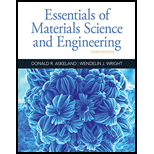
Interpretation:
The primary types of atomic bonds that are carried in ceramics should be determined.
Concept introduction:
A ceramic is kind of solid material that comprises of inorganic material or compounds of metals, non-metals, or metalloid atoms that are initially held in ionic and covalent bonds. Examples of ceramics are brick, porcelain, etc.
Ceramics are widely used for application in domestic, industrial and building products as well as in the wide range of ceramic application in arts. The general properties of ceramics are high hardness, poor conductivity, high elasticity, etc.
Answer to Problem 15.1P
The types of primary atomic bonding used in case of ceramics are ionic bonding and covalent bonding.
Explanation of Solution
Atomic bonds: atoms having attraction among them with a long-lasting chemical bond is termed as atomic bonds. There are following two types of atomic bonds that are used in the case of ceramics:
- Ionic bonding: the complete transfer of valance electrons between atoms that generate two opposite charged chemical ions is said to be ionic bonding.
- Covalent bonding: when the elements are in same or near in terms of periodic table position, the bonding arises by sharing of electrons among the atoms. This type of bonding is named as covalent bonding. In order to attainstability, they share electrons as none of the atoms has a tendency to donate electrons.
In the procedure of bonding, the metal loses an electronand become positively charged ions and non- metal has the tendency to accept the same electron to become a negatively charged anion.
Ionic bonding and covalent bonding are the types of primary atomic bonding used in case of ceramics.
Want to see more full solutions like this?
Chapter 15 Solutions
Essentials Of Materials Science And Engineering
- My ID# 016948724 last 2 ID# 24 Last 3 ID# 724 Please help to find the correct answer for this problem using my ID# first write le line of action and then help me to find the forces {fx= , fy= mz=arrow_forwardmy ID is 016948724 Last 2 ID# 24 Last 3 ID# 724 please help me to solve this problem step by step show me how to solve first wirte the line actions and then find the forces {fx=, fy=, mz= and for the last step find the support reactions and find forcesarrow_forwardSolve this problem and show all of the workarrow_forward
- Can I get help with this case please, thank youarrow_forwardUppgift 1 (9p) 3 m 3 m 3 m 3 m H G F 3 m ↑ Dy D B AAY 30° 8 kN Ay Fackverket i figuren ovan är belastat med en punktlast. Bestäm normalkraften i stängerna BC, BG och FG.arrow_forwardDon't use ai to answer I will report you answerarrow_forward
- Don't use ai to answer I will report you answerarrow_forwardFind the individual offset of each segments below 1 00052800: doba 2c29 653e a123 9a98 1d5d 980e 9f40 2. 0017ce00: 46b5 847d 61ab b29e 44c7 6933 64a9 b6b2 3. 0027ebf0: d13b 45d7 0699 7699 2568 868a 3cae 444earrow_forwardQ3/A unity-feedback system with the forward transfer function G(S)= K S(S+7) is operating with a closed-loop step response that has 15% overshoot. Do the following: a. Evaluate the steady-state error for a unit ramp input. b. Design a lag compensator to improve the steady-state error by a factor of 20 to get a new dominant closed-loop poles S-3.4+ j5.63. place the pole of the lag compensator at s=-0.01 c. Design a lag compensator using OP amp if R1= 100KS2 R2=10 KS2 and R3= 10Karrow_forward
- Q2: (33 Marks) Design FBD for manufacturing system where a conveyor belt is used to move a cart through a tunnel for processing. The process begins when a worker presses a start push button located at the start of the conveyor. Once the start push button is pressed, the cart moves forward along the conveyor belt and enters the tunnel. When the cart reaches the end of the tunnel, it stops automatically and remains in place for 10-minutes to complete a required operation, such as cooling or drying. After the 10-minute delay, the cart automatically returns to the starting point where the worker is stationed. The system then waits for the worker to press the start push button again, at which point the process is repeated. Start PBO Stop PBO LSI 0 LS 2 Motorarrow_forward1. Find the resolution, current and output voltage for a binary weighted resistor DAC of (applied binary word is (locoj), the resistor values R = 12 kQ, Rf = 6 k2 and VR = 12 V. 2. Convert the following 5-bit digital values (ble 10) to analog, using the R-2R ladder. Assume that the Vs = 10 V, R = Rf = 7 ksarrow_forward= = Q1/A cantilever sheet-pile wall penetrating a granular soil. Here, L₁= 3 m, L2 = 6 m, y 17.3kN/m³, Ysat 19.4 kN/m², and 0= 30. a. What is the theoretical depth of embedment, D? b. For a 30% increase in D, what should be the total length of the sheet piles? c. What should be the minimum section modulus of the sheet piles? Use σall = 172 MN/m².arrow_forward
 MATLAB: An Introduction with ApplicationsEngineeringISBN:9781119256830Author:Amos GilatPublisher:John Wiley & Sons Inc
MATLAB: An Introduction with ApplicationsEngineeringISBN:9781119256830Author:Amos GilatPublisher:John Wiley & Sons Inc Essentials Of Materials Science And EngineeringEngineeringISBN:9781337385497Author:WRIGHT, Wendelin J.Publisher:Cengage,
Essentials Of Materials Science And EngineeringEngineeringISBN:9781337385497Author:WRIGHT, Wendelin J.Publisher:Cengage, Industrial Motor ControlEngineeringISBN:9781133691808Author:Stephen HermanPublisher:Cengage Learning
Industrial Motor ControlEngineeringISBN:9781133691808Author:Stephen HermanPublisher:Cengage Learning Basics Of Engineering EconomyEngineeringISBN:9780073376356Author:Leland Blank, Anthony TarquinPublisher:MCGRAW-HILL HIGHER EDUCATION
Basics Of Engineering EconomyEngineeringISBN:9780073376356Author:Leland Blank, Anthony TarquinPublisher:MCGRAW-HILL HIGHER EDUCATION Structural Steel Design (6th Edition)EngineeringISBN:9780134589657Author:Jack C. McCormac, Stephen F. CsernakPublisher:PEARSON
Structural Steel Design (6th Edition)EngineeringISBN:9780134589657Author:Jack C. McCormac, Stephen F. CsernakPublisher:PEARSON Fundamentals of Materials Science and Engineering...EngineeringISBN:9781119175483Author:William D. Callister Jr., David G. RethwischPublisher:WILEY
Fundamentals of Materials Science and Engineering...EngineeringISBN:9781119175483Author:William D. Callister Jr., David G. RethwischPublisher:WILEY





